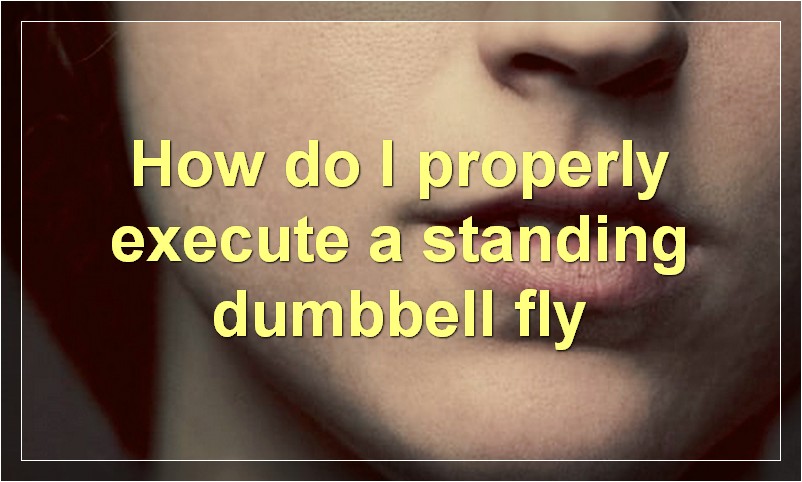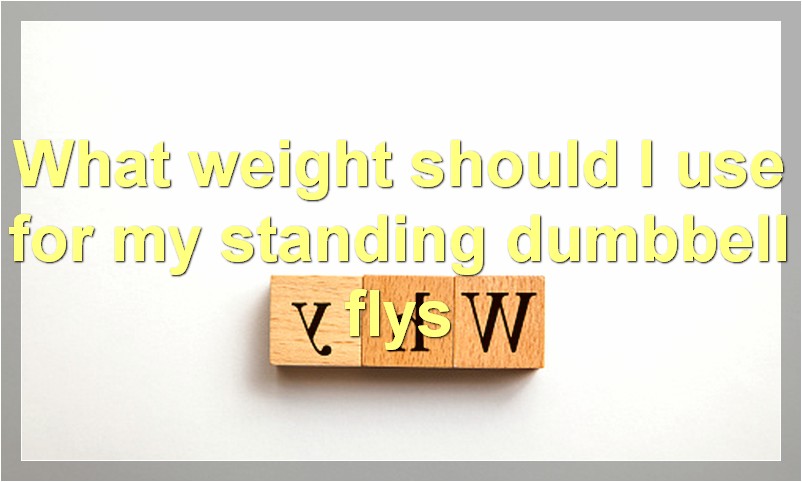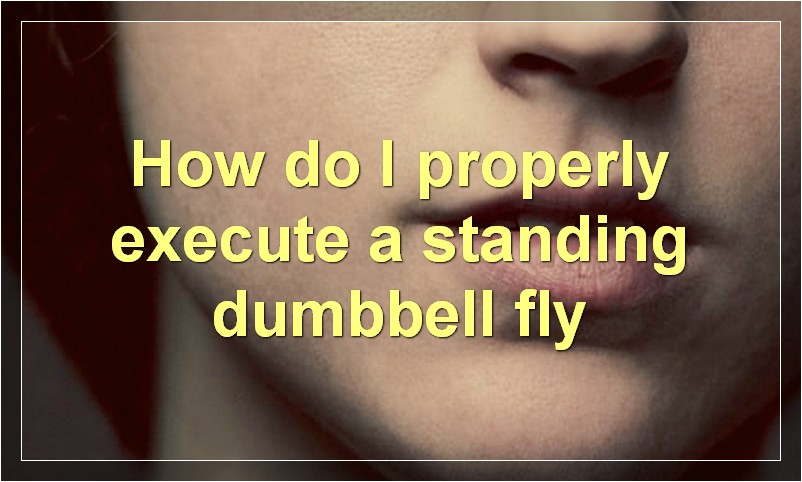Are you looking for a challenging move to add to your chest workout? If so, the standing dumbbell fly is a great option. This move not only helps build muscle, but it also provides a great stretch. Here’s everything you need to know about how to do the standing dumbbell fly, what muscles it works, and some tips for getting the most out of this exercise.
How do I properly execute a standing dumbbell fly?

The standing dumbbell fly is a great exercise for targeting the muscles in your chest, specifically the pectoralis major. This exercise can be performed with a variety of dumbbell weights, making it perfect for both beginners and experienced lifters alike. Here’s how to properly execute a standing dumbbell fly:
Start by standing tall with your feet shoulder-width apart and a dumbbell in each hand. Let the dumbbells hang down at arm’s length by your sides, with your palms facing in toward your thighs.
Keeping your core tight and back straight, slowly raise the dumbbells up to shoulder height, keeping your palms facing each other the entire time. At the top of the movement, squeeze your chest muscles before slowly lowering the dumbbells back down to the starting position.
Repeat for 8-12 reps before switching sides.
What muscles does a standing dumbbell fly work?
The standing dumbbell fly is an exercise that works the muscles of the chest, shoulders, and arms. This exercise can be performed with a variety of weights, but is most commonly done with light to moderate weights. The standing dumbbell fly can be done with one arm at a time or with both arms at the same time.
What are some tips to help me get the most out of my standing dumbbell flys?
If you’re looking to add some serious size to your chest, then you need to be incorporating some fly movements into your routine. The standing dumbbell fly is a great exercise for developing the outer portion of the pecs, and when done correctly, can lead to some impressive gains. Here are some tips to help you get the most out of your standing dumbbell flys:
1. Use A Light Weight
When performing standing dumbbell flys, it’s important to use a weight that is light enough that you can maintain good form throughout the entire range of motion. This exercise is not about lifting heavy weights, but rather about isolating the chest muscles and getting a good stretch. Start with a weight that feels comfortable and increase the weight gradually as you get stronger.
2. Keep Your Elbows Soft
One of the biggest mistakes people make when doing standing dumbbell flys is keeping their elbows locked in place. This puts unnecessary stress on the elbow joints and takes away from the effectiveness of the exercise. Instead, keep your elbows slightly bent and allow them to move freely as you raise and lower the dumbbells.
3. Don’t Swing The Weights
Another common mistake is swinging the weights up and down in an uncontrolled manner. This not only takes away from the effectiveness of the exercise, but can also lead to injury. Be sure to control the weights at all times and focus on using your chest muscles to do the work.
4. Breathe Properly
Breathing properly is crucial for any type of resistance training, but it’s especially important when doing standing dumbbell flys. As you lower the weights, inhale deeply and then exhale as you raise them back up to the starting position. This will help ensure that you’re getting enough oxygen to your muscles and will also help stabilize your core.
5. Perform A Full Range Of Motion
In order to fully maximize the benefits of this exercise, be sure to perform a full range of motion. This means lowering the weights all the way down until your arms are parallel with the floor and then raising them back up until your arms are fully extended overhead. Don’t cheat yourself by not going through a complete range of motion – it won’t be nearly as effective.
By following these tips, you can be sure that you’re getting the most out of your standing dumbbell flys and making progress towards your goals. Give them a try and see how they work for you!
Are there any variations of the standing dumbbell fly that I should be aware of?
Yes, there are definitely variations of the standing dumbbell fly that you should be aware of! The most common variation is the angled dumbbell fly, which targets the muscles in a different way. Another variation is the single-arm dumbbell fly, which allows you to focus on one side at a time. There are also other variations that focus on different muscle groups, such as the pec-fly and the shoulder-fly.
What weight should I use for my standing dumbbell flys?

When it comes to choosing the right weight for standing dumbbell flys, the key is to start light and gradually increase the weight until you find a comfortable weight that allows you to perform the exercise with good form.
For many people, this will be in the 10-15 pound range. If you are new to working out, start with the lower end of this range and work your way up. Once you have found a weight that you can safely and effectively use, stick with it for 4-6 weeks before increasing the weight.
When performing standing dumbbell flys, good form is essential in order to avoid injury and get the most out of the exercise. Be sure to keep your back straight and core engaged throughout the movement, and focus on keeping your elbows slightly bent as you raise and lower the dumbbells.
If you are looking for a challenging workout, add standing dumbbell flys to your routine. By using the proper weight and maintaining good form, you can tone your shoulders, chest, and arms while improving your overall strength and fitness level.
How many sets and reps of standing dumbbell flys should I do?
How many sets and reps of standing dumbbell flys should I do?
This is a question that plagues many would-be gym-goers. The truth is, there is no one-size-fits-all answer to this question. The number of sets and reps you do should be based on your individual fitness goals.
If your goal is to build muscle, then you should focus on doing fewer reps with heavier weights. This type of lifting will help to increase your strength and size. If your goal is to tone your muscles and improve your cardiovascular fitness, then you should focus on doing more reps with lighter weights.
The best way to determine how many sets and reps of standing dumbbell flys you should do is to talk to a certified personal trainer. They will be able to tailor a workout plan that is specifically designed for you and your goals.
Can I incorporate standing dumbbell flys into my upper body workout routine?
Are you looking to add some variety to your upper body workout routine? If so, you may be wondering if you can incorporate standing dumbbell flys into your routine.
Standing dumbbell flys are a great way to target your shoulders, chest and upper back. They can also be used to help correct imbalances between your left and right sides.
To perform a standing dumbbell fly, start by holding a dumbbell in each hand with your palms facing in. Bend your knees slightly and hinge at your hips so that your torso is leaning forward at about a 45-degree angle.
Keep your core engaged and your back flat as you raise the dumbbells out to the sides, maintaining the bend in your elbows. Return to the starting position and repeat for 8-12 reps.
If you have any injuries or health conditions, please consult with your doctor or physical therapist before adding standing dumbbell flys (or any new exercise) to your routine.




